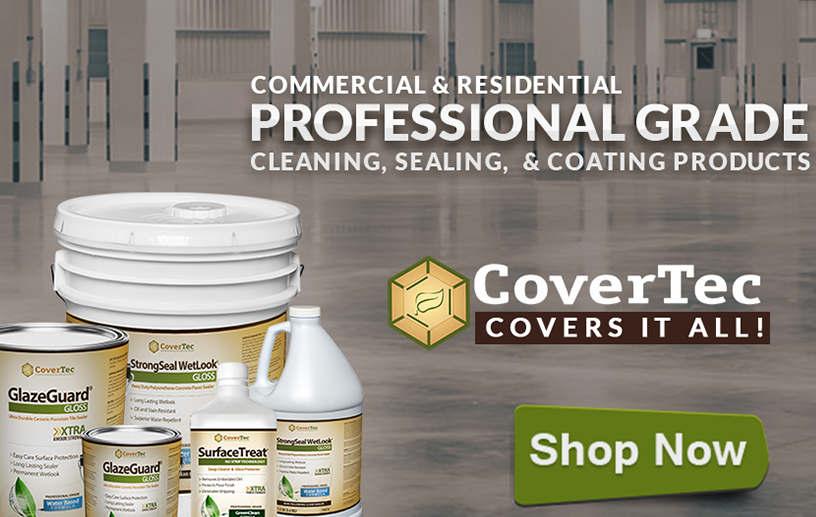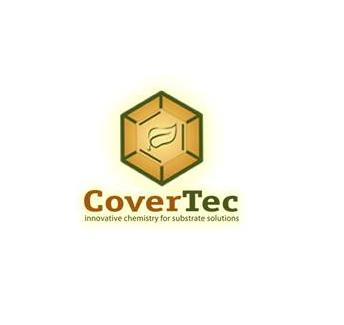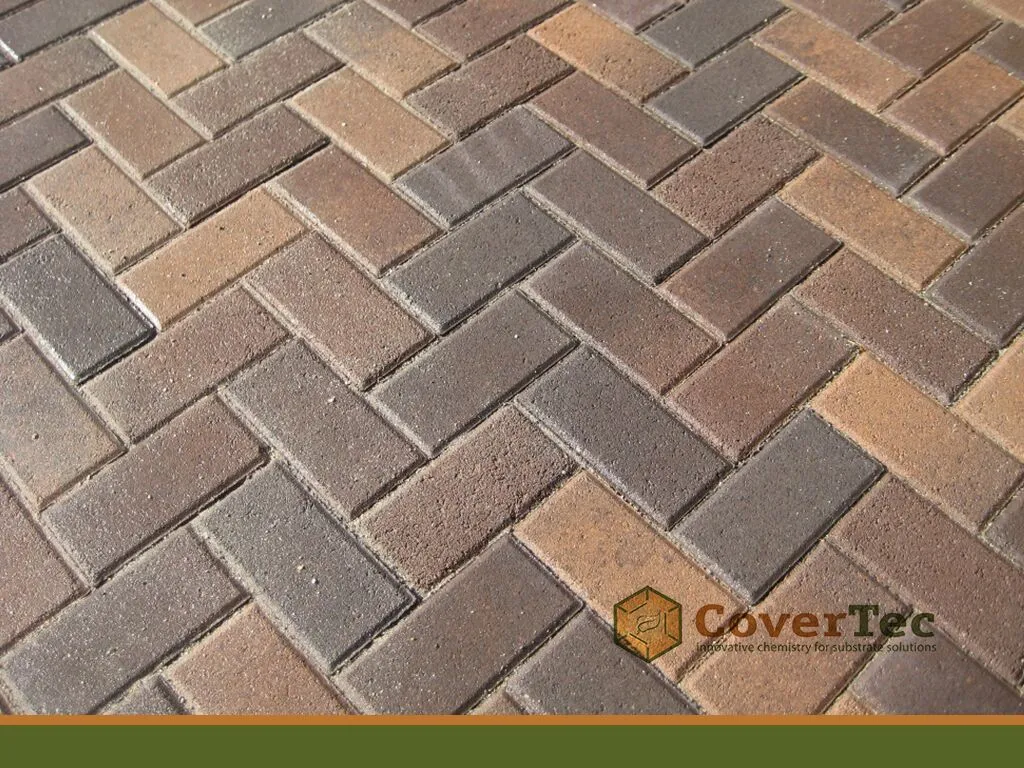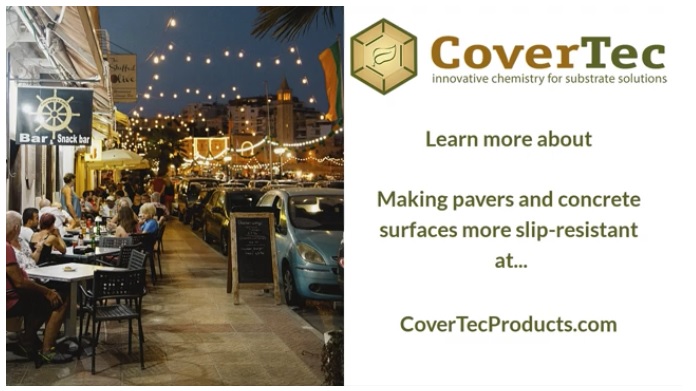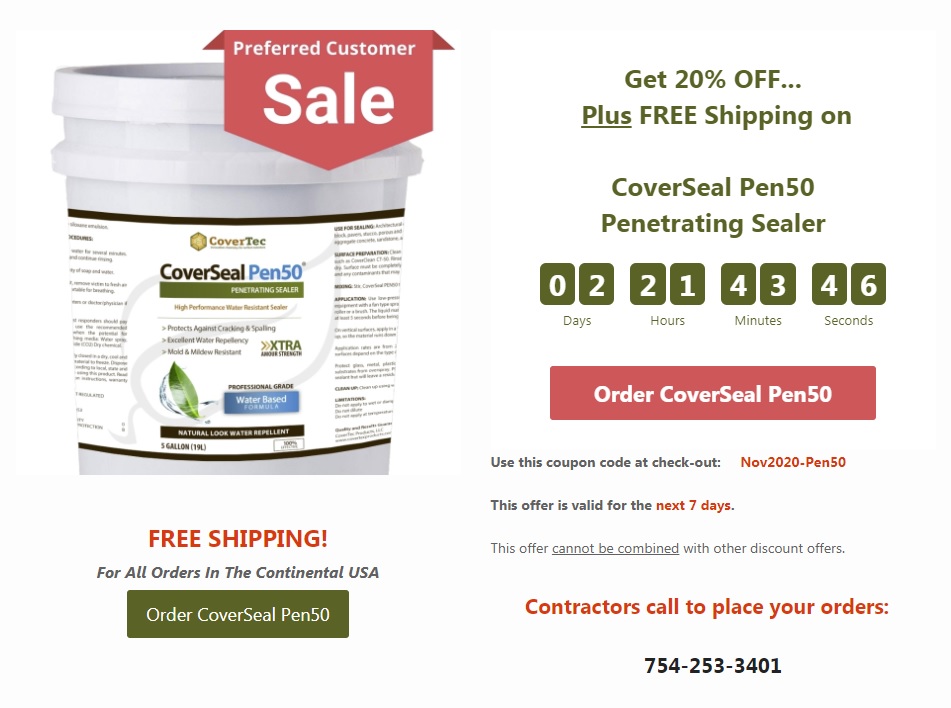You want to know why some tile sealers for ceramic and porcelain are better than others?
Let me share what I believe you want to know to make a smart decision.
What Should You Look For & Look Out For When Choosing A Tile Sealer?
LOOK FOR:
1) The supplier or the manufacturer is very clear that their sealer will bond to ceramic and porcelain because this type of surface is very dense. It is very impermeable. You CAN NOT just use a standard concrete surface sealer on ceramic and porcelain tiles. Check for that, first of all.
2) The tile sealer product will form a film on the surface and is not just a penetrating or impregnator type sealer.
NOTE:
Impregnator types of products can’t bond or soak into the tile surface. They do very little to change the look of the tile and typically, this type of sealer will rub off very quickly, forcing you to seal the porcelain or ceramic tiles repeatedly.
LOOK OUT FOR or BEWARE OF…

Materials That Are Lacking In Store-Bought Tile Sealer Products… Making Them Ineffective.
First of all, any sealer you choose for ceramic and porcelain tile must have adhesion promoters that will allow the product to bond to that surface.
The components found in standard surface treatments or surface sealers simply won’t work.
Secondly, make sure if you want to change the look of the tile or the sheen of the tile, the product is a film-forming product, not just a penetrating or impregnator sealer.
These do very little to change the look of the tile and will not last for long on a very dense, impermeable ceramic or porcelain surface.

What Kind Of Results Do Ineffective Floor Sealers Produce?
If you use a product that’s not developed specifically for ceramic and porcelain tile, what’s going to happen is:
- It may put a film over the surface, but because there’s no way for it to absorb into the surface. It’s going to lift and peel very quickly.
- It may last a few weeks, but after any standard use or cleaning of any kind, lifting and peeling will very quickly show up.
- If you use penetrating types of sealers, you won’t see any change in appearance, or very little at all because there’s nowhere for those components to penetrate the tile.
What Should You Be Aware Of Before You Buy A Tile Sealer?
3 Specific Things To Look For In A Tile Sealer That Will Provide Superior Results:
- You need to have adhesion promotion technology that allows for covalent bonding to a very dense ceramic or porcelain tile surface.
- You need to use urethane technology, which is very durable, UV resistant. Your product needs to have two parts to create a very tough cross-link that produces an industry-leading seal over the tile and grout.
- Your sealer needs a high amount of polymer in the product for durability and protection, around 50% solids, which is much higher than standard floor finishes.
The Advantages Of Sealing Ceramic And Porcelain Tile.
- Easy Maintenance and Cleaning
- Protective Shield Across Tile & Grout
- Eliminate Grout Odor
- Maintains Wet Look
- UV stable, Non-Yellowing
- Chemical Resistant
- Excellent Abrasion resistant
- Increased slip resistance options
Where Should You Use Ceramic And Porcelain Tile Sealer Products?
Typical Uses:
On the commercial side, you’re going to have restrooms, shower facilities, kitchens, showrooms, entrance-ways, hallways, lobby areas and stairways, both interior and exterior.
On the consumer or residential side, in the living areas, kitchens and the bathrooms.
These areas below are where you should look for a tile sealer that will make the floor much easier to clean, give it wet look if desired and also be resistant to chemicals, pet and food stains.
- Bathrooms/ Restrooms
- Kitchens and Dining Areas
- Lobby and Hallways
- Stairs and Entrances
- Tile and Grout Surface
- Floors and walls
- Ceramic and Porcelain
- Stone and Concrete
- Interior and Exterior
- Etc.
Surface Preparation
Proper preparation is critical to ensure an adequate bond.
The ceramic and grout must be thoroughly cleaned with an appropriate cleaner. For cleaning and restoring old ceramic, porcelain tile and grout to like-new condition, we recommend using an alkaline cleaner formulated for ceramic and porcelain tile.
This will cut through tough grease, soap scum and soil stains. For shower stalls and outside applications, we recommend you use an acid-based cleaner to lightly etch the surface and ensure greater adhesion in wet conditions. This can also remove tough, hard water deposits, grout haze and efflorescence.

What Do You Need To Know About A Gloss, Matte Or Satin Finish?
Substances that may soil the tile and grout are urine or other organic matter or even aggressive cleaning chemicals. This is where a two-part product, like GlazeGuard® Ceramic and Porcelain tile sealer really produces results.
It’s a very tough, hard-wearing sealer. It puts a barrier across the tile and the grout, eliminates odor and makes the entire floor much easier to clean and maintain. For addition slip resistance ( anti- slip properties) GlazeGuard® Plus should be used.
GlazeGuard Gloss sealer is developed specifically for ceramic and porcelain tiles. It will put a clear sealer across the floor tile and grout, giving it a high gloss wet look appearance, as well as provide a barrier that will protect against chemicals and soiling and make the floor much easier to clean.
GlazeGuard Satin finish is designed to specifically bond to ceramic and porcelain tile. It also gives the floor a wet look appearance and puts a nice medium sheen across the tile and the grout. The satin finish provides a protective barrier that will resist water, chemicals and make the floor much easier to keep clean.
GlazeGuard Matte finish is designed to specifically bond to ceramic and porcelain tile, and it will deliver a natural low sheen look to the tile and provide a barrier across the floor, both the tiles and the grout. It’s very chemical resistant, very water-resistant and makes the tile much easier to keep clean.
GlazeGuard® Plus is a solvent-free, virtually odorless, urethane coating with exceptional adhesion and performance properties. The addition of CoverGrip achieves high slip resistance, significantly reducing the potential for a slip in accordance with the National Floor Safety Institute (NFSI) standards.

The Best Tools And Equipment To Use.
In order to apply a ceramic and porcelain tiles sealer, you need to approach it as if you were painting the floor.
You will need:
- A good quality roller
- A roller tray
- A little hotdog roller or brush for sealing around the edges.
We recommend a roller that is a good quality 3/8th nap microfiber. Change out rollers after 60 minutes of use with a fresh one. We also recommend that you only mix the amount of product that you can use in about 60 minutes.
Make sure the room is well lit and that you take your time and apply the product. The product needs to be fully mixed before you use it. Use a mixing stick to slowly mix the material, then pour it into a roller tray. Then roll it out just like you were painting a floor.

Cleaning And Preparing Tiles Before Applying A Sealer.
We always tell people to be fussy about cleaning porcelain tile before sealing it.
Remember, you’re going to seal it with something that’s going to last several years. Make sure there’s no dust or dirt on the floor. Any footprints or stains will be locked down by the sealer.
So be fussy about cleaning it. You should use a High pH tile and grout cleaner that will remove dirt grease stains.
If applying GlazeGuard to areas that are frequently exposed to water or cleaning chemicals, like showers or restrooms, we recommend you micro-etch the surface with something like our PreTreat Mild Acidic Ceramic Tile Cleaner. It will prepare the surface and give you better adhesion for the GlazeGuard® sealer.

After Applying The Product, What Ongoing Floor Care Is Recommended?
One of the key advantages of using our GlazeGuard tile sealers is that it makes cleaning and maintaining the floor much easier.
You don’t need to use harsh or aggressive chemicals. You just need to use mild detergents or mild soap to clean the surface. The dirt won’t stick to the surface as it does with untreated tiles.
You don’t have to use a concentrated level of cleaning supplies, which should reduce your costs noticeably.
It’s also important to keep dust and dirt and sand off the floor. It’s a good practice to use mats at entrance ways to trap dirt, dust and grease before they get onto the floor.

What Are Customers Saying About Glazeguard®?
Our Clients Love The Entire Glazeguard® Product Line For A Few Key Reasons:
- They are very water-resistant and prevent stains and discoloration from excessive exposure to moisture or continuous immersion.
- They are very chemical resistant and prevent harmful and staining substances from getting through to the floor below.
- They improve the appearance of ceramic and porcelain floors and walls, for much longer than store-bought sealers.
- They don’t strip off easily and require gentle cleaning with everyday soaps or detergents.
- They reduce the costs of cleaning, maintenance and labor because once sealed, dirt, stains and discolorations are a thing of the past.
- And if something goes wrong, the customer can simply strip that local area and re-apply the GlazeGuard® product.
- They protect both the tile floor and the grout, to keep surfaces clean and odor-free.
Every product in the GlazeGuard® line makes ceramic and porcelain floors look pristine and easy to maintain. And applying them is easy enough for the average do-it-yourself consumer.

